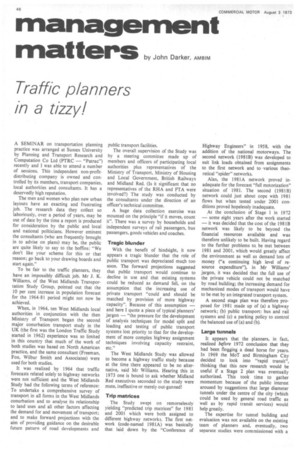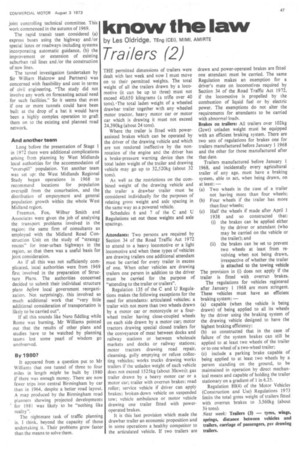management
Page 48

Page 49

If you've noticed an error in this article please click here to report it so we can fix it.
matters by John Darker AM B M
Traffic planners in a tizzy!
A SEMINAR on transportation planning practice was arranged at Sussex University by Planning and Transport Research and Computation Co Ltd (PTRC — "Patrac") recently and I was able to attend a number of sessions. This independent non-profitdistributing company is owned and controlled by its members, transport companies, local authorities and consultants. It has a deservedly high reputation.
The men and women who plan new urban layouts have an exacting and frustrating job. The research data they collect so laboriously, over a period of years, may be out of date by the time a report is produced for consideration by the public and local and national politicians. However eminent the consultants (who are frequently brought in to advise on plans) may be, the public are quite likely to say to the boffins: "We don't like your scheme for this or that reason; go back to your drawing boards and start again."
To be fair to the traffic planners, they have an impossibly difficult job. Mr J. K. Williams, of the West Midlands Transportation Study Group, pointed out that the 10 per cent increase in population forecast for the 1964-81 period might not now be achieved.
When, in 1964, ten West Midlands local authorities in conjunction with the then Ministry of Transport began the second major conurbation transport study in the UK (the first was the London Traffic Study started in 1962) experience was so limited in this country that much of the work of both studies was based on North American practice, and the same consultant (Freeman, Fox, Wilbur Smith and Associates) were used for both studies.
It was realized by 1964 that traffic forecasts related solely to highway networks were not sufficient and the West Midlands Study had the following terms of reference: To undertake a comprehensive survey of transport in all forms in the West Midlands conurbation and to analyse its relationship to land uses and all other factors affecting the demand for and movement of transport; and to make forward projections with the aim of providing guidance on the desirable future pattern of road developments and public transport facilities.
The overall supervision of the Study was by a steering committee made up of members and officers of participating local authorities plus representatives of the Ministry of Transport, Ministry of Housing and Local Government, British Railways and Midland Red. (Is it significant that no representatives of the RHA and FTA were involved?) The study was conducted by the consultants under the direction of an officer's technical committee.
A huge data collection exercise was mounted on the principle "if it moves, count it". There was a survey by households and independent surveys of rail passengers, bus passengers, goods vehicles and coaches.
Tragic blunder With the benefit of hindsight, it now appears a tragic blunder that the role of public transport was depreciated much too soon. The forward projections suggested that public transport would continue to decline in use and that existing systems could be reduced as demand fell, on the assumption that the increasing use of private transport "could and should be matched by provision of more highway capacity". Because of this assumption — and here I quote a piece of typical planners' jargon — "the pressure for the development of analysis techniques for model split and loading and testing of public transport systems lost priority to that for the development of more complex highway assignment techniques involving capacity restraint, etc."
The West Midlands Study was allowed to become a highway traffic study because at the time there appeared to be no alternative, said Mr Williams. Hearing this in 1973 one is bound to ask whether Midland Red executives seconded to the study were mute, ineffective or merely out-gunned!
Trip matrices The Study swept on remorselessly yielding "predicted trip matrices" for 1981 and 2001 which were both assigned to different highway networks. The first network (code-named 1981A) was basically that laid down by the "Conference of Highway Engineers" in 1958, with the addition of the national motorways. The second network (1981B) was developed to suit link loads obtained from assignments to the first network and to -various theoretical "spider" networks.
Alas, the 1981A network proved inadequate for the forecast "full motorization" situation of 1981. The second (1981B) network could just about cope with 1981 flows but when tested under 2001 conditions proved hopelessly inadequate.
At the conclusion of Stage 1 in 1972 — some eight years after the work started — it was decided that the cost of the 1981B network was likely to be beyond the financial resources available and was therefore unlikely to be built. Having regard to the further problems to, be met between 1981 and 2001, which would greatly affect the environment as well as demand lots of money ("a continuing high level of resource expenditure"), in Mr Williams' jargon, it was decided that the full use of the private vehicle could not be matched by road building; the increasing demand for mechanized modes of transport would have to be met by an integrated transport system.
A second stage plan was therefore proposed for 1981 made up of (a) a highway network; (b) public transport: bus and rail systems and (c) a parking policy to control the balanced use of (a) and (b).
Large tunnels It appears that the planners, in fact, realized before 1972 conclusion that they had been flogging a dead horse for years. In 1969 the MoT and Birmingham City decided to look into "rapid transit", thinking that this new research would be useful if a Stage 2 plan was eventually authorized. This took time to gather momentum because of the public interest aroused by suggestions that large diameter tunnels under the centre of the city (which could be used by general road traffic as well as by rapid transit services) would help greatly.
The expertise for tunnel building and evaluation was not available on the existing team of planners and, eventually, two separate studies were commissioned with a joint controlling technical committee. This work commenced in the autumn of 1969.
The rapid transit team considered (a) express buses using the highway and /or special lanes or roadways including systems incorporating automatic guidance, (b) the improvement or extension of existing suburban rail lines and/or the construction of new lines.
The tunnel investigation (undertaken by Sir William Halcrow and Partners) was concerned with feasibility and cost in terms of civil engineering. "The study did not involve any work on forecasting actual need for such facilities." So it seems that even if one or more tunnels could have been built at the drop of a hat it would have been a highly complex operation to graft them on to the existing and planned road network.
And another team
Long before the presentation of Stage 1 in 1972 there were additional complications arising from planning by West Midlands local authorities for the accommodation of "overspill' population. Yet another team was set up: the West Midlands Regional Study began operations in 1968 to recommend locations for population overspill from the conurbation, and the distribution of employment and general population growth within the whole West Midland region.
Freeman, Fox, Wilbur Smith and Associates were given the job of analysing the transport problems involved in the region; the same firm of consultants as employed with the Midland Road Construction Unit on the study of "strategy routes" for inter-urban highways in the region, so that there was a useful basis for joint consideration.
As if all this was not sufficiently complicated, local authorities were from 1969 first involved in the preparation of Structure Plans. The authorities concerned decided to submit their individual structure plans before local government reorganization. Not surprisingly, this involved so much additional work that "very little additional consideration of transportation is likely to be carried out".
If all this sounds like Nero fiddling while Rome was burning. Mr Williams pointed out that the results of other plans and studies have to be watched by planning teams lest some pearl of wisdom go unobserved,
By 1980?
It appeared from a question put to Mr Williams that one tunnel of three to four miles in length might be built by 1980 if there was enough money. There are now fewer trips into central Birmingham by car than in 1964, despite a better road layout. A map produced by the Birmingham road planners showing projected developments for 1981 was likely to be "nothing like The nightmare task of traffic planning is. I think, beyond the capacity of those undertaking it. Their problems grow faster than the means to solve them.
































































































